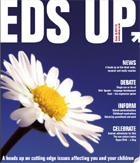
click above to browse
through
the current issue


Want to see your child's
work in print? The winner
will receive a �25 book voucher.
Email:
[email protected]
DOWN’S TESTING LOTTERY
Dr Anne Mackie, the head of NHS screening programmes recently
spoke to The Guardian voicing her concerns on the testing of
pregnant women for Down’s Syndrome.
Over 140 healthy babies are estimated to be lost each year
because the most accurate of the four methods for testing for
Down’s syndrome is only used by 30% of hospitals. Dennis
Campbell, Health correspondent in The Guardian reports that 70%
of hospitals in England “still use tests that are more likely to give a
“false positive” – assessing women wrongly as at a high risk of
having a Down’s child.”
The newer combined test is still only available in certain parts of
London, the South-East, South-West and the Midlands despite the
NHS promise that it would be ready to offer the new test to every
woman by March 2010.
The combined test is taken between 10 and 14 weeks of pregnancy
and consists of a blood test and an ultrasound which measures the
fluid pocket behind the baby’s neck (the Nuchal Translucency).
Another method is amniocentesis in which a needle is inserted into
the sac containing the baby’s amniotic fluid. The babies die when
the mother miscarries as a result of the test (which involves a 1%
risk of miscarriage). Says Mackie: “Combined testing is the best.
It produces the most accurate results. It, in effect, saves lives.”
The Guardian offers some interesting statistics: “A total of 366,000
women in England had one of the four tests last year. Of those,
18,300 were deemed high risk and 14,640 decided to then have
an amniocentesis test. Those tests identified 1,112 babies with
Down’s and, in 92.8% of those cases the woman had a termination.
Women who become mothers after 35 (which is nowadays
becoming more and more common), are more likely to have a
Down’s child, especially after the age of 40.
|

